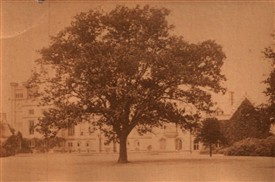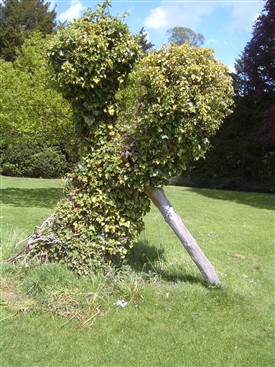The Byron Oak

The 'Byron Oak' on the south lawn at Newstead Abbey in c.1905

The Byron Oak today - only a stump remains
Ralph Lloyd-Jones
Situated in the grounds at Newstead Abbey - Lord Byron's ancestral home in Nottinghamshire - the 'Byron Oak' was a tree planted by the poet himself
Describing the tree as it appeared in 1850, an anonymously published booklet entitled A Visit to Sherwood Forest (Mansfield: Collinson, 1850, p.33) said "It has now attained a goodly size, considering the slow growth of the oak, and bids fair to become a lasting memento of the noble bard, and to be a shrine to which thousands of pilgrims will resort in future ages to do homage to his mighty genius.
"He planted it on his first arrival at Newstead, in 1798, and ever after displayed 'the greatest regard for its prosperity', actuated, it is said, by an impression or fancy, that as the tree flourished so should he; 'As it fares', said he, 'so will fare my fortunes'.
"When he again visited the abbey in 1807, he found his pet tree choked up with weeds and almost destroyed, which circumstance called forth those charming lines:-
" Young oak, when I planted thee deep in the ground,
I hoped that thy days would be longer than mine;
That thy dark waving branches would nourish around
And ivy thy trunk with its mantle entwine,"
Financial pressures ultimately forced Byron to put Newstead up for sale, but it proved difficult to find a buyer. Byron left England in 1816, never to return.
In 1818, the estate was purchased for £94,500 by Col. Thomas Wildman, a friend from Byron's school days. Wildman spent a further £100,000 refurbishing the house and gardens.
It is said that shortly after Colonel Wildman took possession of the Abbey, he one day noticed this tree, and said to the servant who was with him, ' here is a fine young oak but it must be cut down, as it grows in an improper place'
'I hope not, sir,' replied the man, 'for it is the one that my Lord was so fond of, because he set it himself.'
As our picture shows, the oak did obscure the south facade of the Abbey, so one can perhaps understand Col. Wildman's initial reaction.
Needless to say, however, the tree was not removed, and in the years after every possible care was accorded the tree.
Its remains still survive at Newstead today - although, sadly, it is now little more than a stump.